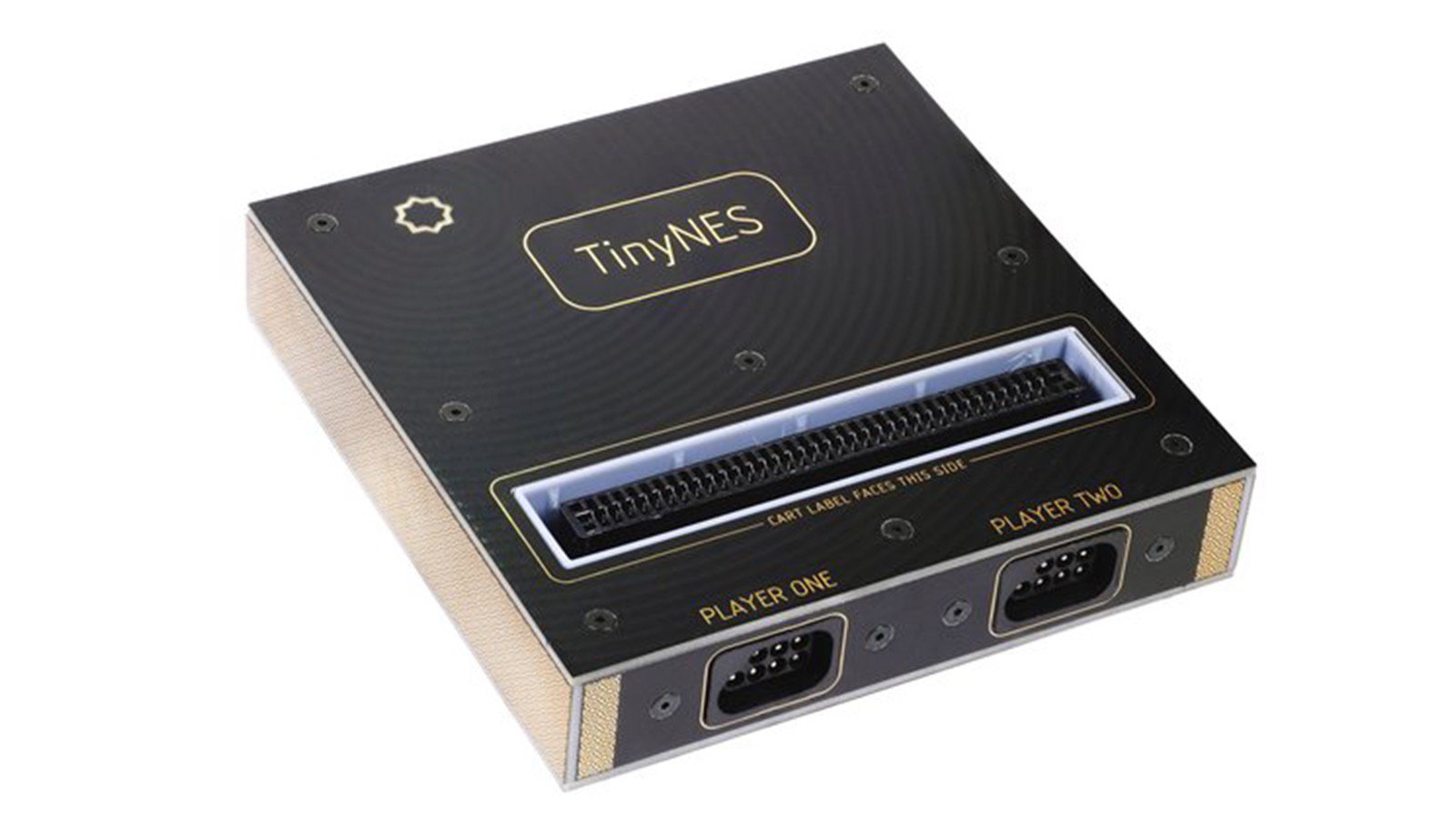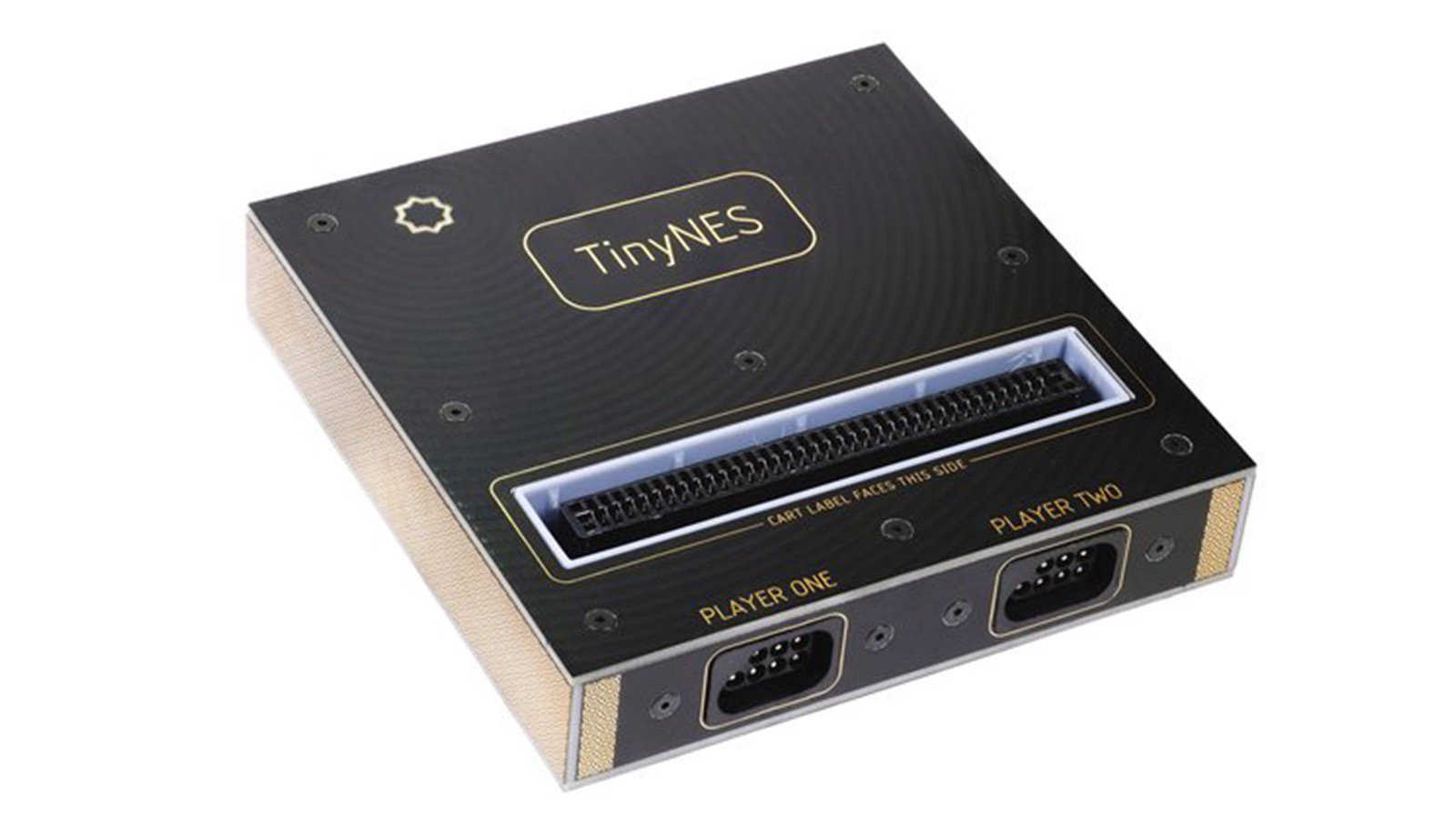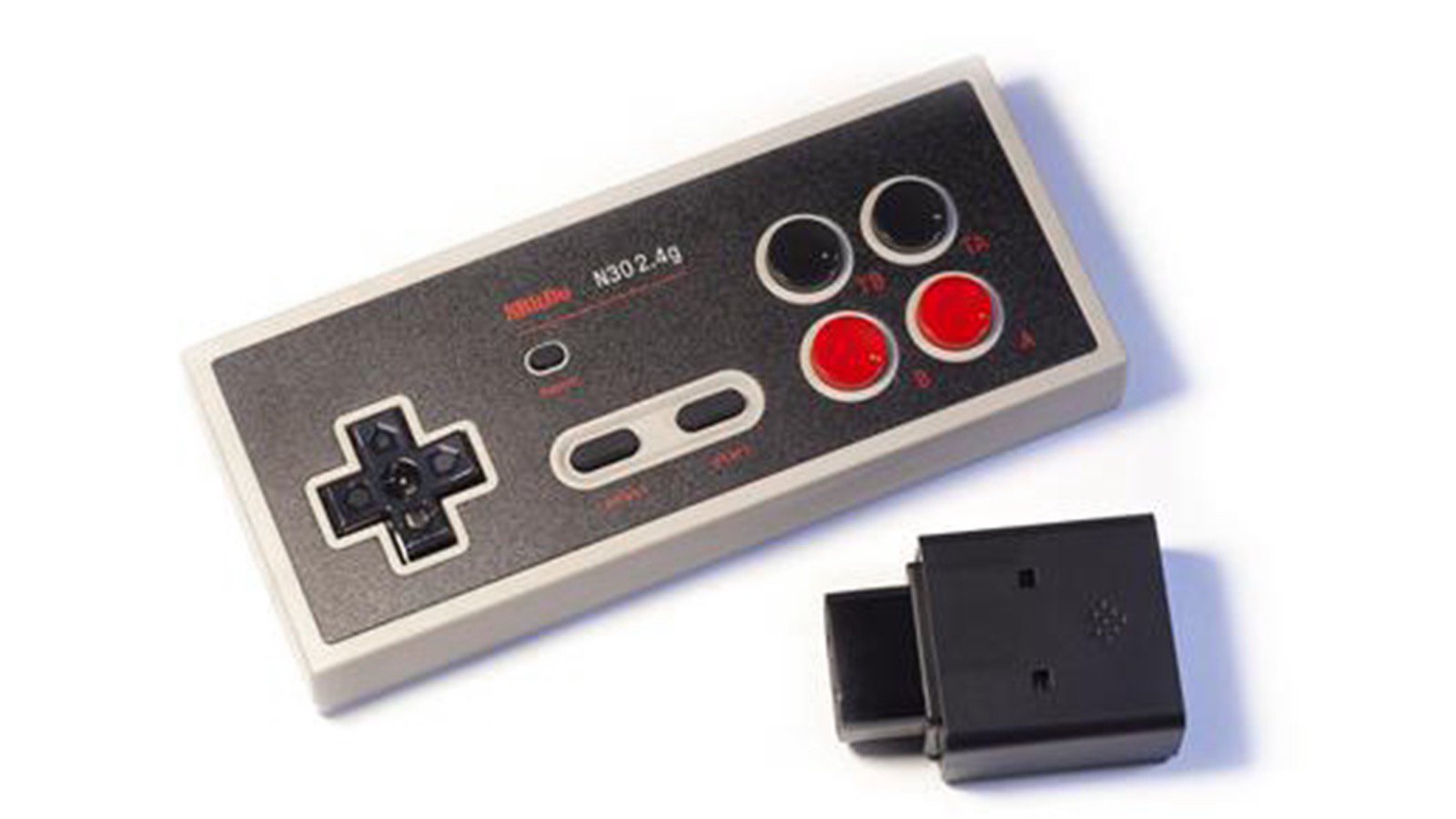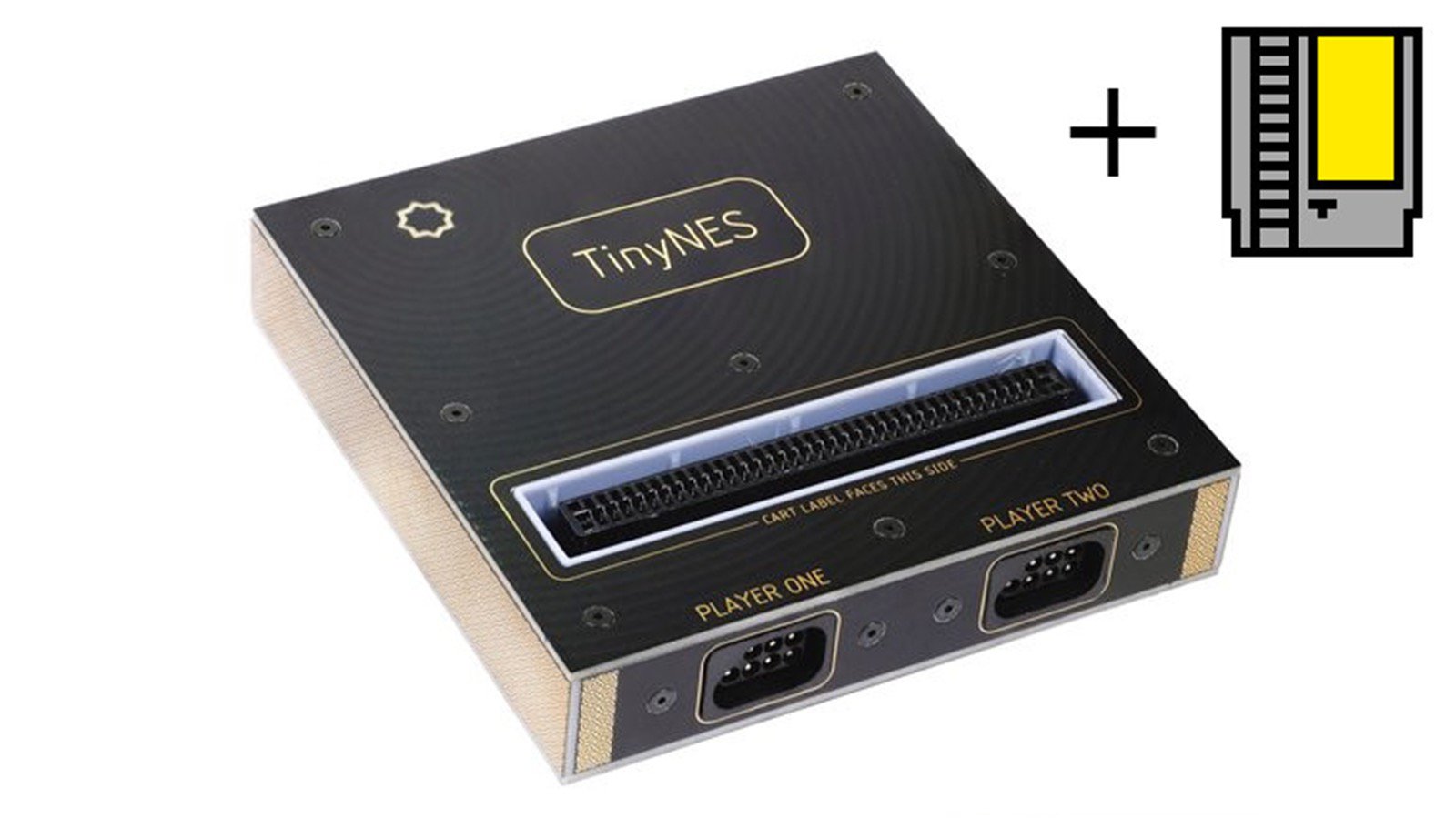Tall Dog Electronics
Gaming
Vintage
TinyNES
Classic NES games on open source hardware that fits in the palm of your hand
Funding ended on Jan 27, 2022 at 03:59 PM PST.
Tall Dog Electronics
Gaming
Vintage
Funding ended on Jan 27, 2022 at 03:59 PM PST.
TinyNES (short for Tiny Nostalgia Evocation Square) is an open hardware video game console that plays original Nintendo Entertainment System (NES) video game cartridges, without using emulation.
This tiny console was designed with size, simplicity, cost, modern manufacturability, and component availability in mind. It has a strong little enclosure made from FR-4 (circuit board material) and it can be powered by a simple USB Type-C cable, like the one that you already use to charge your phone. It’s cute, sturdy, and fun to play.
I grew up absolutely mesmerized by the original Nintendo, as well as the 16-bit consoles that came after it. When I ran across an original Famicom (Japanese version of the NES) factory schematic, I began working on this project as a simple exercise in product design, and that eventually turned into a polished, reliable device, that I thought other people might like to use to play their old carts, or to disassemble and learn from, or to use as a starting point for their own projects. I hope you like it! It’s been a lot of fun to design and build.
This is not the first NES clone system out there, nor will it be the last, but I hope it will become one of your favorites. You don’t need to solder it together yourself (if you don’t want to), and you won’t need to jailbreak or reflash it in order to play any game you want (though you will have to track down some carts). Since all the elements of the design are open source, you can also use TinyNES as a jumping-off point for your own derivative hardware designs.
TinyNES doesn’t have very many tricks up its sleeve. It doesn’t upscale graphics or output HDMI or RGB video signals. It doesn’t communicate with your computer, your phone, or the internet. It doesn’t come pre-loaded with games (legal nor illegal), and it doesn’t allow you to save state, alter the color palette, or remap the controls. It doesn’t have any menus or configuration.
TinyNES does do what it’s supposed to: It plays NES games just like an original Nintendo system would, except it takes up less space, consumes less power, is a completely open source design, and is built from almost entirely modern components. It has a power switch, a reset button, a cartridge slot, two controller slots, and it outputs beautiful crisp analog video and audio signals to your TV.
TinyNES is not an emulator, nor is it built around an FPGA (field programmable gate array) or a NOAC (NES-on-a-chip) solution. The heart of TinyNES is exactly the same as the original Nintendo hardware: the MOS 6502-based Ricoh RP2A03 CPU (central processing unit) and the Ricoh RP2C02 PPU (picture processing unit). By using these two original chips, the console is able to achieve excellent compatibility.
These chips aren’t made anymore, so they’re a bit tricky to find. Fortunately, I’ve already managed to secure enough of them for this production run. They’re in-hand and have already been tested. The TinyNES main board is built with IC sockets to mount these chips, so they don’t need to be permanently soldered. This way, if need-be, the main board can be upgraded, swapped out, or modified, and these two valuable and somewhat rare core chips don’t need to be subjected to any risk of permanent damage.
A cheaper and slightly more sustainable option is to use clone chips in place of the genuine Ricoh ones mentioned above. These clones are the UMC UA6527 CPU and the UMC UA6528 PPU. There are minor documented differences in functionality with these, but most people won’t notice any difference. A number of TinyNES units using these close chips are also available at a slightly reduced price. If the TinyNES remains in production after this initial run, any future units will probably use these clone chips due to their wider availability and much cheaper price.
Whether a set of genuine or clone chips is installed in the sockets, the rest of the TinyNES hardware is identical.
TinyNES is fully open source hardware. The design (mechanical, electrical, and aesthetic) is licensed under the CC BY-SA 4.0 (Creative Commons Attribution-ShareAlike 4.0 International) license. This means that all the design files are available for your inspection, modification, or derivative use. You can create new projects using these files—including commercial projects—as long as you give credit to all earlier (“upstream”) creators and your derivative work is released under the same open source license (or an officially compatible one).
What all this means is that you get to access the schematics, board layouts, CAD files, and BOMs (bills of materials) for everything that goes into the building of the console. You could use these files to build a TinyNES completely from scratch, if you wanted to.
TinyNES works with any NES interface device, including Nintendo’s original high-quality wired controllers, as well as the cheaper aftermarket alternatives that are still being made. Used genuine Nintendo controllers can often be found on eBay, but we couldn’t reliably source enough of them to include one with each TinyNES. Most of the (dirt cheap) aftermarket controllers that we tested weren’t able to meet our standards for quality and reliability.
However, the 8BitDo N30 2.4g wireless gamepad managed to exceed our expectations. Each controller includes the wireless gamepad itself, a wireless receiver (the part that plugs into the console), a USB charging cable, and printed instructions, all bundled together in 8BitDo’s beautiful retail packaging.
Please note that these bundled controllers don’t support Bluetooth. 8BitDo does make very similar looking controllers that do support Bluetooth, but they also require an additional (expensive) Bluetooth receiver for the NES. Both versions work great with TinyNES, but we decided to bundle the simpler, less expensive option.
The quality of these controllers is very good. Button presses consistently register correctly, latency is extremely low, and the fit and finish is far above average for aftermarket accessories. I don’t think you’ll be disappointed by this controller. We are offering the controllers as add-on products, so you can order however many you want to use with your TinyNES.
TinyNES may not be loaded with fancy features, but it still has some modern niceties under the hood.
First, instead of using a simple bipolar transistor to amplify the console’s video output, TinyNES uses a Texas Instruments THS7314 chip, resulting in a cleaner and more stable video signal. Conversely, the analog audio signal path has been kept as similar to the original NES console as possible.
The console’s power circuitry incorporates a supervisor chip that eliminates the need to hold the RESET button while powering off the console in order to prevent the corruption of certain saved game data. There are some games that use on-screen instructions to encourage taking this extra step, which can be disregarded when using TinyNES.
The clock circuitry is controlled by a highly-accurate MEMS oscillator instead of a quartz crystal. Additionally, a separate 1.25× CPU frequency multiplier circuit can be enabled via an internal switch. This allows the original processor to be overclocked, or it allows for glitch-free operation using cheap and ubiquitous UA6527P chips. These “P” chips have an internal clock divider of 15 as opposed to UA6527 chips that have an internal clock divider of 12, but are otherwise identical. As it turns out, many UA6527 chips on the market are actually repackaged UA6527P chips. This multiplier circuit allows them to work perfectly.
This last thing is just kind of strange and it has no immediate tangible benefit. The TinyNES main board uses two 32 kB SRAM chips, even though the NES system only needs 2 kB chips. Yes, this means there’s 16 times more memory just sitting there. Why? For some reason, 32 kB chips are much cheaper than 2 kB chips. Want to put this extra memory to good use? TinyNES is entirely open source, so please go ahead and implement something cool.
TinyNES has a custom designed enclosure fabricated from 2 mm thick FR-4 circuit board panels. It’s rock solid and has a very satisfying feel in your hands, and we think it looks pretty sweet too. As you might have guessed from the name, the console is also small. It’s about the same size as an NES game cartridge. It’s also very easy to service, requiring only a standard hex key (also known as an Allen wrench), and it even comes with the one you need.
A ZIF (zero insertion force) connector was used on the original front-loading NES console, and unfortunately this part frequently resulted in unreliable electrical contact between the cartridge and the main board because of dust buildup and subtle wear (deformation) over time to the metal contacts. TinyNES uses a reliable board-edge socket connector in a top-loading configuration to eliminate any problems caused by the ZIF connector.
A lockout (“CIC”) chip was present in the original NES as a copy-protection mechanism, allowing only games that were licensed by Nintendo (and which contained a special matching chip) to run. Unfortunately, this lockout system would often misfire and cause the console to blink on and off once per second (also known as the “blink of death”) when electrical contact was poor (often due to a failing ZIF connector) even when a completely legitimate licensed game cartridge (with special chip and all) was inserted. The TinyNES console, much like the original Japanese Famicom console, has no lockout chip, and doesn’t suffer from this problem. This also means that you can play unofficial (non-licensed) games just fine.
At this time, there is (unfortunately) one cartridge known to be incompatible with the TinyNES console. This cart is the RetroUSB PowerPak, a ROM loader cartridge that uses CF cards for storage. This cart hangs at its title screen. The PowerPak isn’t open-source, so we don’t quite know why it doesn’t work. Do you think you have the skills to help fix this issue? Please reach out! If a fix for this is found in the future, updated main boards will be made available.
Of course, not every other game cartridge in existence has been rigorously tested, but everything else that we’ve gotten our hands on and thrown at the system (over 100 original carts) has worked, including the very awesome Krikzz EverDrive N8 (a ROM loader cartridge that uses SD cards for storage).
Main boards and controller socket boards will be fabricated and assembled by PCBWay, a factory with whom we have a significant amount of experience. They will purchase most of the discrete electrical components directly from distributors.
The five different enclosure panels will also be manufactured by PCBWay at the same time. These panels will be assembled (soldered) together into enclosures by us, using a custom alignment jig.
Controller socket cables will be made by Cloom, a custom cable manufacturer who we have worked with before. Plastic cartridge guides will be 3D printed using SLA (stereolithography) by a vendor on Treatstock, a 3D printing marketplace.
Final mechanical assembly will be done by us, as well as the installation of core chips, functional testing, and packaging. All of the core chips have already been purchased, received, and tested. Any custom packaging elements will be manufactured by a combination of EcoEnclose, Forests Packaging, and/or New England Foam.
Controllers, power adapters, and cables will be purchased from a variety of suppliers. The specific models of each accessory have already been sampled and selected for quality.
Fulfillment and final shipment to backers will be handled exclusively by Crowd Supply from their distribution center in Mansfield, TX, USA. Prior to that, all consoles and accessories will be assembled, tested, and enclosed in their packaging by Tall Dog Electronics.
For backers within the United States, most orders will be shipped via UPS. International orders will be shipped primarily via DHL or FedEx.
For more information on shipping, please see the Crowd Supply Guide.
A unique risk for this project is the fact that it utilizes two of the chips found in the original Nintendo Entertainment System and Famicom consoles that were custom-manufactured for Nintendo by Ricoh in the ‘80s, ‘90s, and early ‘00s. These chips, the RP2A03 and the RP2C02, are no longer being commercially produced (as far as I know). Likewise, the alternate UMC clone chips UA6527, UA6527P, and UA6528 are not available through traditional authorized component distributors, and must be purchased via secondary markets. However, to mitigate these risks, I have already stockpiled and tested enough of these chips to fulfill all of the currently scheduled reward slots.
Another potential risk is the ongoing COVID-19 pandemic and the interruptions and delays it has introduced into the global supply chain, including shipment delays. These delays could result in fulfillment being pushed back, and are largely outside of my control.
The remaining risks are those that are typical of any hardware project, including unexpected component sourcing problems, production delays, factory mistakes, yield issues, and the logistics of assembling physical objects made from hundreds of tiny parts. As someone who has been operating Tall Dog Electronics for several years now, designing and manufacturing synthesizer equipment as well as development board breakout kits, I’m familiar with all of these risks. There are always unforeseen things that happen, and the challenge is knowing how to roll with these problems while communicating clearly and promptly with customers in the meantime, which we will try our best to do.
All backer rewards come with a one year warranty on parts and labor. In short, if anything goes wrong—through no fault of your own—within one year from receiving your reward, we’ll take care of it and cover the cost of any repair or replacement. Damage, or any modifications that are made by you, aren’t covered under this warranty. Basically, we stand behind the stuff we make. We want it to work well, and we want you to be happy using it. You can always contact us with any questions or support requests.
Due to the nature of this project, unforeseen compatibility issues may be discovered after the project has been released. If that happens, we’ll do our best to sort things out in a reasonable way. We’re not a big company, so we don’t have all the resources for testing and contingency planning that a big company might have at their disposal. We can’t promise compatibility in situations that we haven’t been able to test.
All source material and documentation will be made available through a GitHub repository upon the successful conclusion of this campaign. Links to this repo will be communicated to backers directly and will also able be made available on the campaign landing page, a campaign update page, and/or on a dedicated TinyNES website.
Short version: We don’t want anyone to be misled about who we are or who this project is affiliated with! We are not Nintendo, and we are not affiliated with Nintendo in any way. Any patents related to the original Nintendo Entertainment System have long since expired. We use some of Nintendo’s trademarked (or formerly trademarked) terms on this page, because we’re allowed to in order to describe this project and what its capabilities are, but those terms don’t belong to us. Please don’t contact Nintendo for support.
Longer version: “Nintendo” and “Nintendo Entertainment System” are trademarks of Nintendo of America Inc. in the United States and/or other countries. “NES” was a trademark of Nintendo of America Inc. in the United States until it was cancelled on February 5, 2016. This crowdfunding campaign and the TinyNES project are not affiliated with, endorsed by, associated with, or sponsored by Nintendo of America Inc. nor their affiliates, subsidiaries, partners, officers, or employees, in any capacity whatsoever. Their trademarks are used here to fairly and accurately describe their products, and to fairly and accurately compare their products and services to those being described here. All other product and company names are trademarks or registered trademarks of their respective rights holders. Use of those names or trademarks does not imply any affiliation with or endorsement by them.
"[TinyNES] is a brand new micro-console that has the same processors as the original Nintendo Entertainment System, which means it has native support for the original game cartridges, despite the console itself being about the size of a cartridge."
Produced by Tall Dog Electronics in Easthampton, MA.
Sold and shipped by Crowd Supply.

One TinyNES system, which includes a TinyNES console (with RP2A03 and RP2C02 chips), one USB Type-C cable for power, one dual RCA cable, and one US USB Type-C wall power adapter. CONTROLLER SOLD SEPARATELY.
Want to buy this item? Check the current project page for the latest information.

One TinyNES system, which includes a TinyNES console (with UA6527 and UA6528 chips), one USB Type-C cable for power, one dual RCA cable, and one US USB Type-C wall power adapter. CONTROLLER SOLD SEPARATELY.
Want to buy this item? Check the current project page for the latest information.

One 8BitDo N30 2.4g wireless controller and receiver. Use up to two with TinyNES!
Want to buy this item? Check the current project page for the latest information.

One TinyNES system, which includes a TinyNES console (with RP2A03 and RP2C02 chips), one USB Type-C cable for power, one dual RCA cable, and one US USB Type-C wall power adapter. CONTROLLER SOLD SEPARATELY. This limited quantity pledge level includes one randomly-selected game cartridge.
Want to buy this item? Check the current project page for the latest information.

Mounts to your TinyNES and holds your cartridge securely in place.
Want to buy this item? Check the current project page for the latest information.
An adapter that provides Famicom support. Works with or without a Cart Latch.
Want to buy this item? Check the current project page for the latest information.

Tall Dog has primarily focused on producing a variety of breakout boards for the Teensy microprocessor development platform and conducts the majority of its business via the Tindie marketplace.